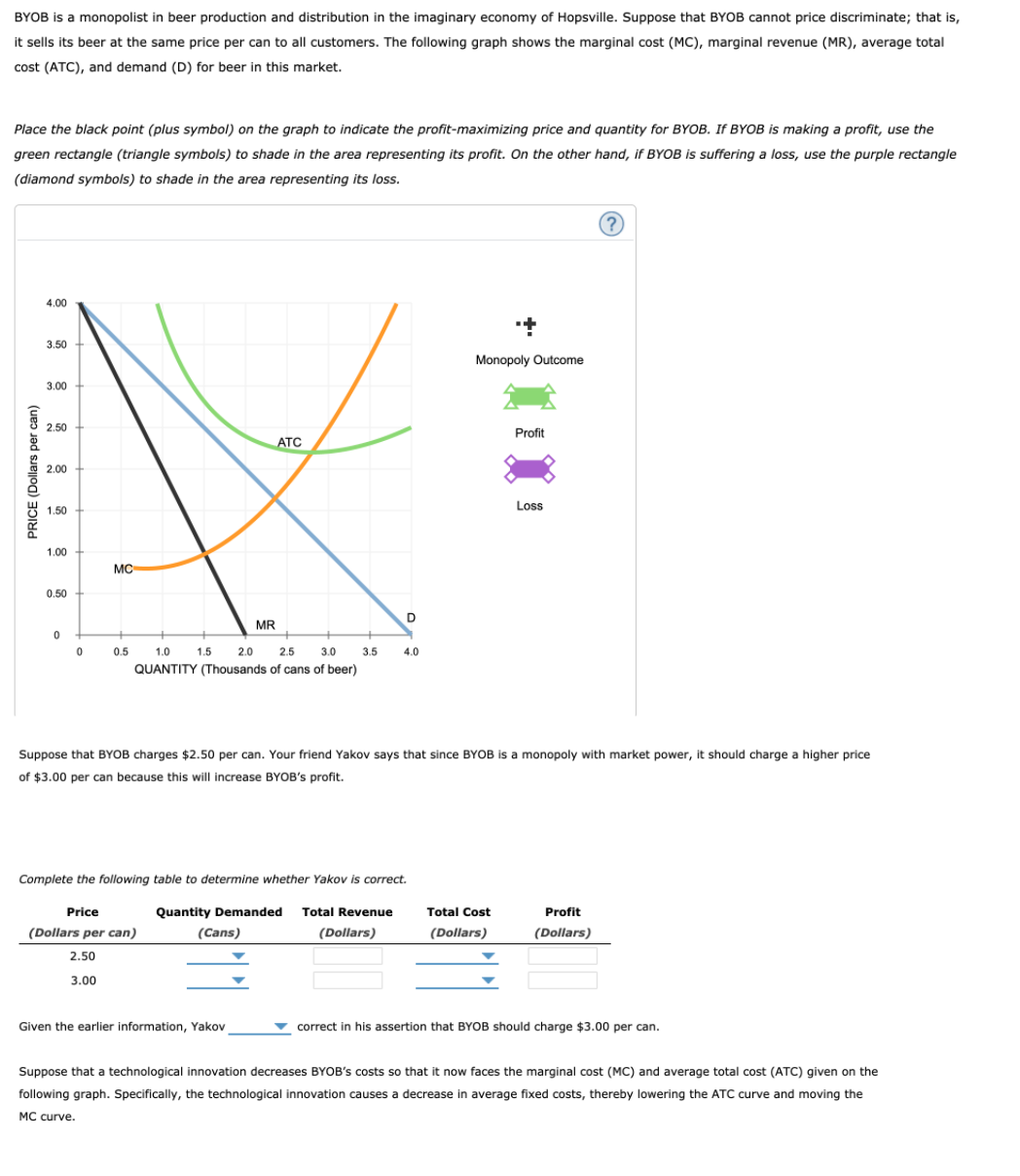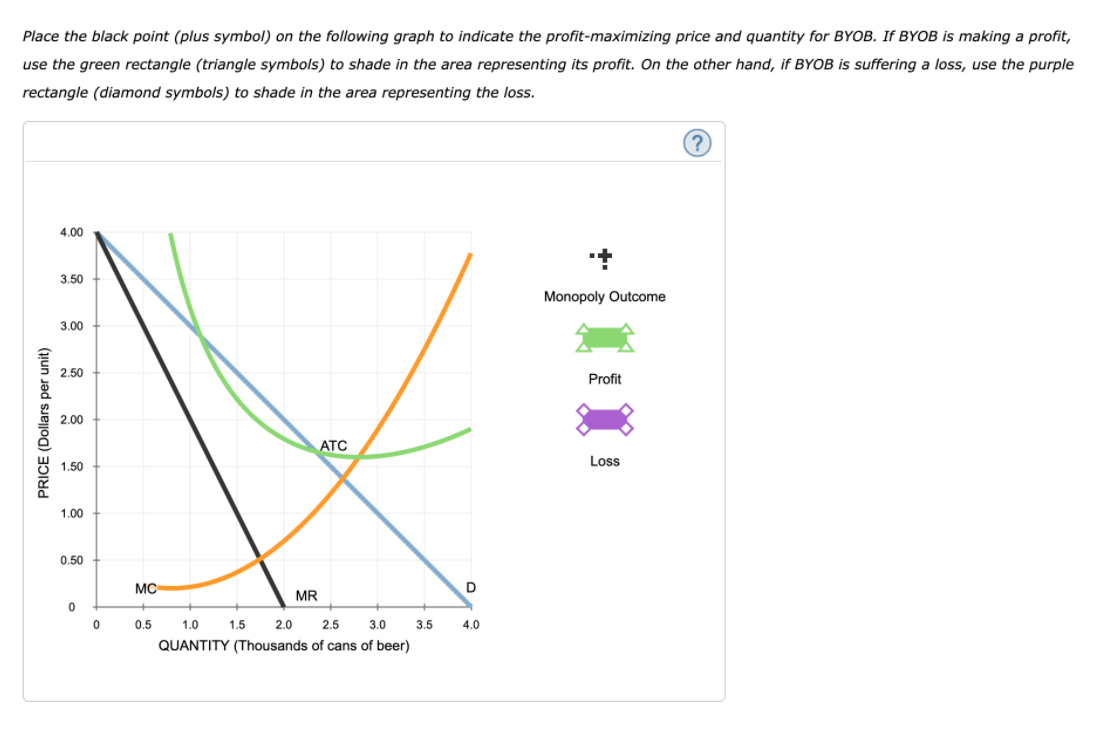BYOB is a monopolist in beer production and distribution in the imaginary economy of Hopsville. Suppose that BYOB cannot price discriminate; that is, it sells its beer at the same price per can to all customers. The following graph shows the marginal cost (MC), marginal revenue (MR), average total cost (ATC), and demand (D) for beer in this market. Place the black point (plus symbol) on the graph to indicate the profit-maximizing price and quantity for BYOB. If BYOB is making a profit, use the green rectangle (triangle symbols) to shade in the area representing its profit. On the other hand, if BYOB is suffering a loss, use the purple rectangle (diamond symbols) to shade in the area representing its loss. (? 4.00 3.50 Monopoly Outcome 3.00 2.50 Profit ATC 2.00 1.50 Loss 1.00 MC 0.50 MR 0.5 1.0 1.5 2.0 2.5 3.0 3.5 4.0 QUANTITY (Thousands of cans of beer) Suppose that BYOB charges $2.50 per can. Your friend Yakov says that since BYOB is a monopoly with market power, it should charge a higher price of $3.00 per can because this will increase BYOB's profit. Complete the following table to determine whether Yakov is correct. Price Quantity Demanded Total Revenue Total Cost Profit (Dollars per can) (Cans) (Dollars) (Dollars) (Dollars) 2.50 3.00 Given the earlier information, Yakov correct in his assertion that BYOB should charge $3.00 per can. Suppose that a technological innovation decreases BYOB's costs so that it now faces the marginal cost (MC) and average total cost (ATC) given on the following graph. Specifically, the technological innovation causes a decrease in average fixed costs, thereby lowering the ATC curve and moving the MC curve. PRICE (Dollars per can) Place the black point (plus symbol) on the following graph to indicate the profit-maximizing price and quantity for BYOB. If BYOB is making a profit, use the green rectangle (triangle symbols) to shade in the area representing its profit. On the other hand, if BYOB is suffering a loss, use the purple rectangle (diamond symbols) to shade in the area representing the loss. 4.00 3.50 Monopoly Outcome 3.00 2.50 Profit 2.00 ATC Loss 1.50 1.00 0.50 MC MR 0.5 1.0 1.5 2.0 2.5 3.0 3.5 4.0 QUANTITY (Thousands of cans of beer) PRICE (Dollars per unit)
BYOB is a monopolist in beer production and distribution in the imaginary economy of Hopsville. Suppose that BYOB cannot price discriminate; that is, it sells its beer at the same price per can to all customers. The following graph shows the marginal cost (MC), marginal revenue (MR), average total cost (ATC), and demand (D) for beer in this market. Place the black point (plus symbol) on the graph to indicate the profit-maximizing price and quantity for BYOB. If BYOB is making a profit, use the green rectangle (triangle symbols) to shade in the area representing its profit. On the other hand, if BYOB is suffering a loss, use the purple rectangle (diamond symbols) to shade in the area representing its loss. (? 4.00 3.50 Monopoly Outcome 3.00 2.50 Profit ATC 2.00 1.50 Loss 1.00 MC 0.50 MR 0.5 1.0 1.5 2.0 2.5 3.0 3.5 4.0 QUANTITY (Thousands of cans of beer) Suppose that BYOB charges $2.50 per can. Your friend Yakov says that since BYOB is a monopoly with market power, it should charge a higher price of $3.00 per can because this will increase BYOB's profit. Complete the following table to determine whether Yakov is correct. Price Quantity Demanded Total Revenue Total Cost Profit (Dollars per can) (Cans) (Dollars) (Dollars) (Dollars) 2.50 3.00 Given the earlier information, Yakov correct in his assertion that BYOB should charge $3.00 per can. Suppose that a technological innovation decreases BYOB's costs so that it now faces the marginal cost (MC) and average total cost (ATC) given on the following graph. Specifically, the technological innovation causes a decrease in average fixed costs, thereby lowering the ATC curve and moving the MC curve. PRICE (Dollars per can) Place the black point (plus symbol) on the following graph to indicate the profit-maximizing price and quantity for BYOB. If BYOB is making a profit, use the green rectangle (triangle symbols) to shade in the area representing its profit. On the other hand, if BYOB is suffering a loss, use the purple rectangle (diamond symbols) to shade in the area representing the loss. 4.00 3.50 Monopoly Outcome 3.00 2.50 Profit 2.00 ATC Loss 1.50 1.00 0.50 MC MR 0.5 1.0 1.5 2.0 2.5 3.0 3.5 4.0 QUANTITY (Thousands of cans of beer) PRICE (Dollars per unit)
Chapter14: Monopoly
Section: Chapter Questions
Problem 14.5P
Related questions
Question

Transcribed Image Text:BYOB is a monopolist in beer production and distribution in the imaginary economy of Hopsville. Suppose that BYOB cannot price discriminate; that is,
it sells its beer at the same price per can to all customers. The following graph shows the marginal cost (MC), marginal revenue (MR), average total
cost (ATC), and demand (D) for beer in this market.
Place the black point (plus symbol) on the graph to indicate the profit-maximizing price and quantity for BYOB. If BYOB is making a profit, use the
green rectangle (triangle symbols) to shade in the area representing its profit. On the other hand, if BYOB is suffering a loss, use the purple rectangle
(diamond symbols) to shade in the area representing its loss.
(?
4.00
3.50
Monopoly Outcome
3.00
2.50
Profit
ATC
2.00
1.50
Loss
1.00
MC
0.50
MR
0.5
1.0
1.5
2.0 2.5
3.0
3.5
4.0
QUANTITY (Thousands of cans of beer)
Suppose that BYOB charges $2.50 per can. Your friend Yakov says that since BYOB is a monopoly with market power, it should charge a higher price
of $3.00 per can because this will increase BYOB's profit.
Complete the following table to determine whether Yakov is correct.
Price
Quantity Demanded Total Revenue
Total Cost
Profit
(Dollars per can)
(Cans)
(Dollars)
(Dollars)
(Dollars)
2.50
3.00
Given the earlier information, Yakov
correct in his assertion that BYOB should charge $3.00 per can.
Suppose that a technological innovation decreases BYOB's costs so that it now faces the marginal cost (MC) and average total cost (ATC) given on the
following graph. Specifically, the technological innovation causes a decrease in average fixed costs, thereby lowering the ATC curve and moving the
MC curve.
PRICE (Dollars per can)

Transcribed Image Text:Place the black point (plus symbol) on the following graph to indicate the profit-maximizing price and quantity for BYOB. If BYOB is making a profit,
use the green rectangle (triangle symbols) to shade in the area representing its profit. On the other hand, if BYOB is suffering a loss, use the purple
rectangle (diamond symbols) to shade in the area representing the loss.
4.00
3.50
Monopoly Outcome
3.00
2.50
Profit
2.00
ATC
Loss
1.50
1.00
0.50
MC
MR
0.5
1.0
1.5
2.0
2.5
3.0
3.5
4.0
QUANTITY (Thousands of cans of beer)
PRICE (Dollars per unit)
Expert Solution
This question has been solved!
Explore an expertly crafted, step-by-step solution for a thorough understanding of key concepts.
This is a popular solution!
Trending now
This is a popular solution!
Step by step
Solved in 3 steps with 5 images

Recommended textbooks for you








Managerial Economics: Applications, Strategies an…
Economics
ISBN:
9781305506381
Author:
James R. McGuigan, R. Charles Moyer, Frederick H.deB. Harris
Publisher:
Cengage Learning

Managerial Economics: A Problem Solving Approach
Economics
ISBN:
9781337106665
Author:
Luke M. Froeb, Brian T. McCann, Michael R. Ward, Mike Shor
Publisher:
Cengage Learning